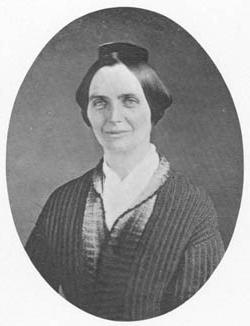From Anti-Slavery to Women’s Rights
In the late 1830s, women worked to advance the anti-slavery movement. In 1837, Lucretia Mott organized the first Anti-Slavery Convention of American Women. Abby Kelley Foster, who lived in Lynn, Massachusetts, traveled to Philadelphia to attend the convention. Inspired by Mott’s work, Foster moved to Worcester and started lecturing in support of the rights of enslaved people and women.
 Abby Kelley Foster
Abby Kelley Foster
 Lucretia Coffin Mott
Lucretia Coffin Mott
Anti-slavery reformers disagreed about whether women should lead the movement. In 1848, Frederick Douglass, a formerly enslaved man who became an anti-slavery author and speaker, attended the women’s rights convention in Seneca Falls, New York, and supported women’s rights his entire life. Thomas Wentworth Higginson, a Massachusetts minister and author, regularly wrote in support of women’s rights, including an essay in the publication Woman’s Rights Tracts.
 Frederick Douglass
Frederick Douglass
 Thomas Wentworth Higginson
Thomas Wentworth Higginson
In 1869, the suffrage movement split over the 15th Amendment, which granted black men the right to vote. Lucy Stone and Julia Ward Howe worked to support the measure, but Susan B. Anthony and Elizabeth Cady Stanton, leaders of the National Woman Suffrage Association, opposed it. Stone and Howe led the American Woman Suffrage Association in Boston and earned a larger following than Anthony and Stanton. In 1890, Stone’s daughter helped unite the two groups under the National American Woman Suffrage Association. By that time, Stone’s health was declining and she chose to focus on The Woman’s Journal. Stanton and Anthony led the new organization and continued to erase Stone from the history of the suffrage movement.
In 1913, two years before Boston’s “Victory Parade,” suffragists marched in Washington, D.C., for the first time. Organizer Alice Paul decided that black women should march in the back. By then, white suffragists had gained some respect from the public, but these activists did not work to extend that support to women of color.
Despite hostility from white suffragists, black suffragists often participated in public protests. Anti-lynching reformer Ida B. Wells-Barnett refused to march in the back of the 1913 parade, so she marched with the Illinois delegation. Mary Church Terrell, former president of the National Association of Colored Women, also marched in the parade with a delegation of black women from Howard University. She believed in “proper, dignified agitation” and later joined suffragists in the nation’s first pickets of the White House in 1917.


